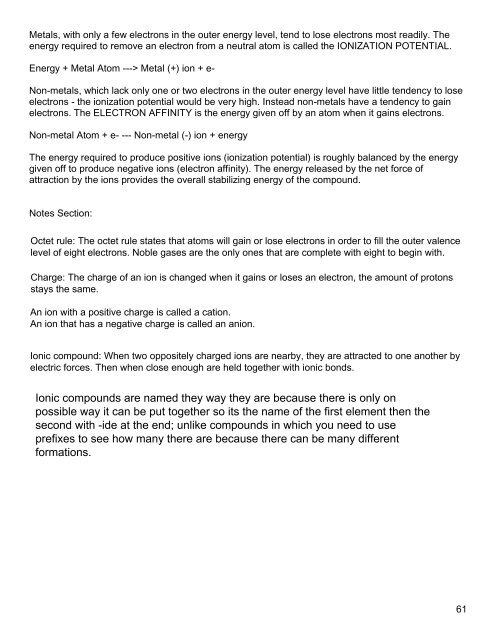1st_semester_notebook_pasco
Create successful ePaper yourself
Turn your PDF publications into a flip-book with our unique Google optimized e-Paper software.
Metals, with only a few electrons in the outer energy level, tend to lose electrons most readily. The<br />
energy required to remove an electron from a neutral atom is called the IONIZATION POTENTIAL.<br />
Energy + Metal Atom ---> Metal (+) ion + e-<br />
Non-metals, which lack only one or two electrons in the outer energy level have little tendency to lose<br />
electrons - the ionization potential would be very high. Instead non-metals have a tendency to gain<br />
electrons. The ELECTRON AFFINITY is the energy given off by an atom when it gains electrons.<br />
Non-metal Atom + e- --- Non-metal (-) ion + energy<br />
The energy required to produce positive ions (ionization potential) is roughly balanced by the energy<br />
given off to produce negative ions (electron affinity). The energy released by the net force of<br />
attraction by the ions provides the overall stabilizing energy of the compound.<br />
Notes Section:<br />
Octet rule: The octet rule states that atoms will gain or lose electrons in order to fill the outer valence<br />
level of eight electrons. Noble gases are the only ones that are complete with eight to begin with.<br />
Charge: The charge of an ion is changed when it gains or loses an electron, the amount of protons<br />
stays the same.<br />
An ion with a positive charge is called a cation.<br />
An ion that has a negative charge is called an anion.<br />
Ionic compound: When two oppositely charged ions are nearby, they are attracted to one another by<br />
electric forces. Then when close enough are held together with ionic bonds.<br />
Ionic compounds are named they way they are because there is only on<br />
possible way it can be put together so its the name of the first element then the<br />
second with -ide at the end; unlike compounds in which you need to use<br />
prefixes to see how many there are because there can be many different<br />
formations.<br />
61






